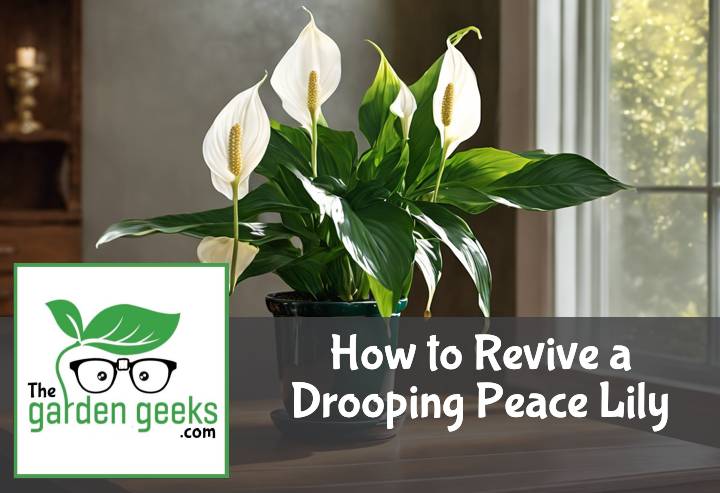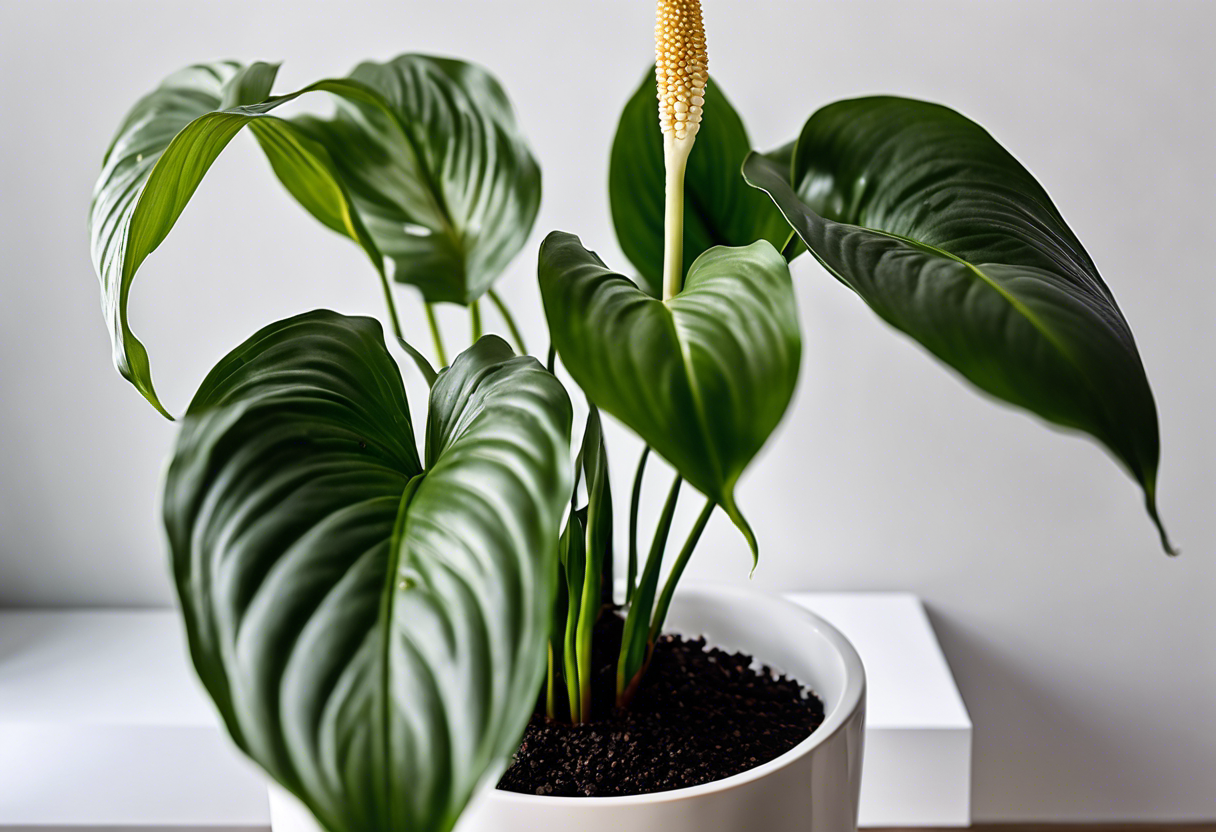Ever found yourself in a panic, wondering How to Revive a Drooping Peace Lily? Trust me, I’ve been there. One day you’re admiring your lush green peace lily, the next it’s wilting and looking rather sorry for itself. It’s like plant parenthood’s version of a horror movie!
But fear not, fellow green thumbs! With some tender loving care and the right know-how, we can nurse our beloved peace lilies back to health. Keep reading about How to Revive a Drooping Peace Lily!
Key Takeaways
- Identify the problem: Overwatering, underwatering, or exposure to extreme temperatures can cause a peace lily to droop.
- Correct watering: Water thoroughly but infrequently, allowing the top inch of soil to dry out between waterings.
- Adjust light and temperature: Peace lilies prefer indirect light and temperatures between 65-85°F.
- Repot if necessary: If the plant is root-bound or the soil is poor, repot with fresh potting mix.
- Use a balanced fertilizer: Apply every 6 weeks during growing season.
Understanding the Peace Lily
The Peace Lily, a real gem among houseplants, is known for its lush green leaves and elegant white blooms. Recognizing a healthy one from a drooping one can be tricky, but with some knowledge about its characteristics and importance, you’ll be able to spot the difference in no time.
What is a Peace Lily?
A Peace Lily isn’t just your average houseplant. Originating from tropical rainforests in America, this plant has made its way into homes worldwide due to its air-purifying qualities. The features of Peace Lily include glossy green leaves, white flowers (which are actually modified leaf bracts), and it’s one of the few types of lilies that prefer shade over sunlight.
Recognizing a Healthy Peace Lily
So, how do you know if your peace lily is thriving? A healthy peace lily will have vibrant green leaves, not too dark or light. The leaf color should be consistent without any brown or yellow spots. Additionally, it should bloom at least once a year – yes, even indoors! Lastly, check out the roots; they should be firm and white – not squishy or brown.
Identifying Signs of a Drooping Peace Lily
Now let’s talk about when things go south. If your peace lily starts showing signs like wilting leaves or lackluster blooms, it might be drooping. Other symptoms of drooping peace lily include yellowing leaves or browning tips – these are clear signals that your plant isn’t happy. Also watch out for changes in growth patterns; if your usually fast-growing peace lily slows down significantly or stops growing altogether, it’s time to take action on how to revive a drooping peace lily.
Causes of a Drooping Peace Lily
When it comes to drooping peace lily causes, there are several common culprits. From watering woes to light issues, temperature tantrums to nutrient nightmares, let’s dive into these peace lily care mistakes.
Inadequate Watering
First up, water – or lack thereof. Under-watering your peace lily can leave it parched and droopy. On the flip side, over-watering can drown the roots, causing similar symptoms. If you’re seeing signs of an overwatered peace lily, like yellow leaves or moldy soil, it’s time for some damage control.
But don’t fret! Correcting water issues in peace lilies is as simple as adjusting your watering schedule. Just remember: when in doubt, less is more!
Poor Light Conditions
Next on our list of reasons for wilting peace lily is lighting. These plants aren’t fans of direct sunlight – too much can scorch their leaves faster than you can say “sunburn”. But they also don’t do well in low light conditions.
So what’s a plant parent to do? Find that sweet spot! A room with filtered light should keep your peace lily happy and healthy.
Incorrect Temperature and Humidity Levels
Temperature and humidity play a big role in peace lily health too. These tropical beauties prefer temperatures between 65-85°F (18-30°C) and high humidity levels.
If these conditions aren’t met, you might find yourself dealing with a droopy peace lily. Dry air can cause brown leaf tips while cold drafts can lead to wilting.
Nutrient Deficiency or Overfertilization
Finally, let’s talk nutrients. Both deficiency and overfertilization can lead to a drooping peace lily. If your plant isn’t getting enough nutrients, it can become weak and wilt. On the other hand, too much fertilizer can burn the roots.
The solution? A balanced plant food applied as directed should do the trick. And remember, how to revive a drooping peace lily often involves a bit of trial and error. So don’t be discouraged if your plant doesn’t perk up overnight!
How to Revive Your Drooping Peace Lily
If your peace lily is looking a bit sad and wilted, don’t fret! It’s common for these plants to droop when they’re not happy. But with the right peace lily care tips, you can revive your drooping peace lily in no time. Let’s dive into how you can fix that wilted peace lily and get it back to its healthy, vibrant self.
Adjusting Watering Practices
Watering is a tricky business when it comes to peace lilies. Too much or too little water can lead to a droopy plant. If you’ve been overwatering or underwatering your peace lily, it’s time to adjust your watering practices. Aim for moist soil – not too wet, not too dry. Remember, proper watering is key for a healthy peace lily maintenance.
Modifying Light Exposure
Light exposure plays a crucial role in the health of your peace lily. If your plant isn’t getting enough light or if it’s getting too much, this could be causing it to droop. Try adjusting the light conditions for your peace lilies by moving them closer to or further from the window as needed. Remember, indoor lighting works well for these plants too!
Regulating Temperature and Humidity
Temperature and humidity levels also have an impact on the health of your peace lily. These plants thrive in warmer temperatures and high humidity levels, so try maintaining optimal climate conditions for them whenever possible. This might mean moving them away from drafty windows or using a humidifier in dry environments.
Correcting Fertilizer Use
Incorrect fertilizer use can harm a peace lily more than help it! Over-fertilization can cause root burn while under-fertilization may leave your plant malnourished. To avoid these issues, follow recommended fertilization techniques for peace lilies. Using a balanced, water-soluble fertilizer every 6-8 weeks during the growing season should do the trick!
Preventive Measures for a Healthy Peace Lily
Preventive measures are the secret sauce to maintaining peace lilies in their prime. It’s all about mastering the art of watering, lighting, temperature control, and fertilization. Let’s dive into these aspects of peace lily care.
Ideal Watering Techniques for Peace Lilies
Watering your peace lily is like making a good cuppa tea. You need to get it just right. Too much water can lead to drooping leaves – not a pretty sight!
The trick here is to wait until the top inch of soil feels dry before you grab that watering can. Remember, overwatering is a common mistake when it comes to watering peace lilies.
Optimal Lighting Conditions for Peace Lilies
Now let’s shed some light on… well, light! Your peace lily isn’t too fussy about lighting conditions but prefers bright, indirect sunlight.
Placing it near an east or north-facing window would be ideal. This way, you’re promoting healthy peace lilies without scorching them with direct sunlight.
Suitable Temperature and Humidity for Peace Lilies
Temperature and humidity play a big role in keeping your peace lily happy and healthy. These plants love temperatures between 65-80°F (18-27°C) and high humidity levels.
Consider placing your plant in a bathroom or kitchen where humidity tends to be higher. This creates an optimal environment for your peace lily, mimicking its natural rainforest habitat.
Proper Fertilization for Peace Lilies
Last but not least, let’s talk grub – plant grub that is! Fertilizing your peace lily helps it grow strong and prevents those dreaded droopy leaves.
A balanced houseplant fertilizer used as directed should do the trick. Just remember not to overdo it – too much of a good thing can be harmful. There you have it, the lowdown on fertilizing peace lilies and keeping them in tip-top shape!
To Wrap Up
In the end, reviving a drooping Peace Lily is like nursing a hangover – hydration, TLC, and a bit of patience. We’ve shared the hows and whys in our post How to Revive a Drooping Peace Lily.
So, don’t fret if your green buddy is looking down. Just remember: water wisely, keep it cozy, and let there be light (but not too much)!





